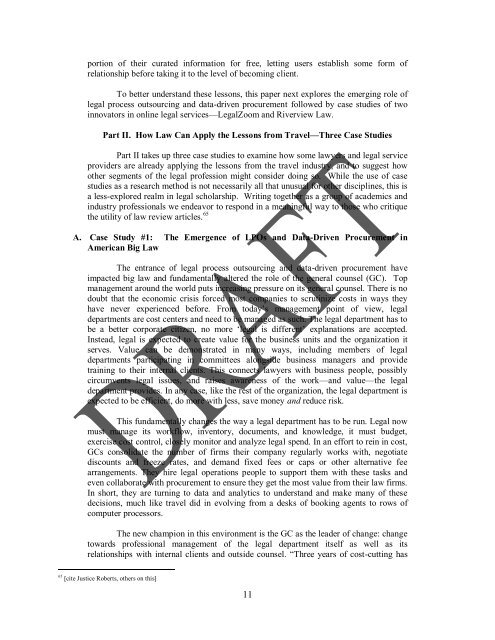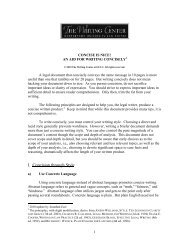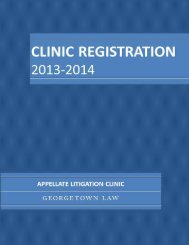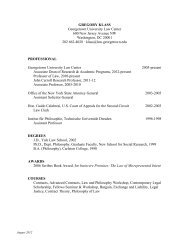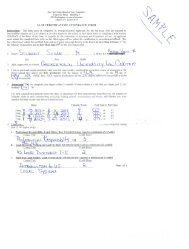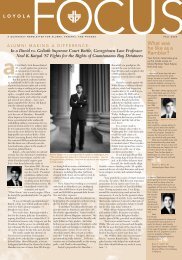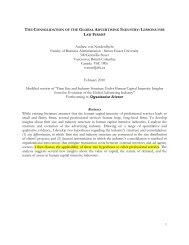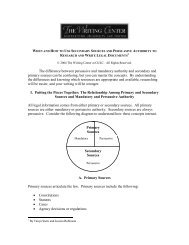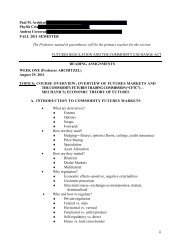Date: April 12, 2013 Topic: The Shrinking ... - Georgetown Law
Date: April 12, 2013 Topic: The Shrinking ... - Georgetown Law
Date: April 12, 2013 Topic: The Shrinking ... - Georgetown Law
You also want an ePaper? Increase the reach of your titles
YUMPU automatically turns print PDFs into web optimized ePapers that Google loves.
portion of their curated information for free, letting users establish some form of<br />
relationship before taking it to the level of becoming client.<br />
To better understand these lessons, this paper next explores the emerging role of<br />
legal process outsourcing and data-driven procurement followed by case studies of two<br />
innovators in online legal services—LegalZoom and Riverview <strong>Law</strong>.<br />
Part II. How <strong>Law</strong> Can Apply the Lessons from Travel—Three Case Studies<br />
Part II takes up three case studies to examine how some lawyers and legal service<br />
providers are already applying the lessons from the travel industry, and to suggest how<br />
other segments of the legal profession might consider doing so. While the use of case<br />
studies as a research method is not necessarily all that unusual for other disciplines, this is<br />
a less-explored realm in legal scholarship. Writing together as a group of academics and<br />
industry professionals we endeavor to respond in a meaningful way to those who critique<br />
the utility of law review articles. 65<br />
A. Case Study #1: <strong>The</strong> Emergence of LPOs and Data-Driven Procurement in<br />
American Big <strong>Law</strong><br />
<strong>The</strong> entrance of legal process outsourcing and data-driven procurement have<br />
impacted big law and fundamentally altered the role of the general counsel (GC). Top<br />
management around the world puts increasing pressure on its general counsel. <strong>The</strong>re is no<br />
doubt that the economic crisis forced most companies to scrutinize costs in ways they<br />
have never experienced before. From today’s management point of view, legal<br />
departments are cost centers and need to be managed as such. <strong>The</strong> legal department has to<br />
be a better corporate citizen, no more ‘legal is different’ explanations are accepted.<br />
Instead, legal is expected to create value for the business units and the organization it<br />
serves. Value can be demonstrated in many ways, including members of legal<br />
departments participating in committees alongside business managers and provide<br />
training to their internal clients. This connects lawyers with business people, possibly<br />
circumvents legal issues, and raises awareness of the work—and value—the legal<br />
department provides. In any case, like the rest of the organization, the legal department is<br />
expected to be efficient, do more with less, save money and reduce risk.<br />
This fundamentally changes the way a legal department has to be run. Legal now<br />
must manage its workflow, inventory, documents, and knowledge, it must budget,<br />
exercise cost control, closely monitor and analyze legal spend. In an effort to rein in cost,<br />
GCs consolidate the number of firms their company regularly works with, negotiate<br />
discounts and freeze rates, and demand fixed fees or caps or other alternative fee<br />
arrangements. <strong>The</strong>y hire legal operations people to support them with these tasks and<br />
even collaborate with procurement to ensure they get the most value from their law firms.<br />
In short, they are turning to data and analytics to understand and make many of these<br />
decisions, much like travel did in evolving from a desks of booking agents to rows of<br />
computer processors.<br />
<strong>The</strong> new champion in this environment is the GC as the leader of change: change<br />
towards professional management of the legal department itself as well as its<br />
relationships with internal clients and outside counsel. “Three years of cost-cutting has<br />
65 [cite Justice Roberts, others on this]<br />
11


